.475 Linebaugh
The .475 Linebaugh is an extremely potent rimmed revolver cartridge developed by John Linebaugh in the late 1980s. The cartridge is based on the .45-70 Government case cut down to 1.5 inches and loaded with .475-inch-diameter (12.1 mm) bullets weighing from 320 grains (21 g) to 440 grains (29 g). Although the .45 Silhouette cartridge is also derived from a .45-70 trimmed down to 1.5 inches, the .475 Linebaugh saw the same case modified to accept .475 caliber bullets, resulting in significantly different ballistic performance.
The then-new .475 Linebaugh was first announced in the May 1988 issue of Guns & Ammo in an article written by Ross Seyfried.
Usage
The .475 Linebaugh is primarily intended for hunting big game or as a backup when confronting dangerous animals. A 370-grain (24 g) bullet starting out at 1,495 feet per second (456 m/s) develops 1,840 foot-pounds force (2,490 J) of energy, and a 440-grain (29 g) bullet at 1,360 feet per second (410 m/s) develops 1,800 foot-pounds force (2,400 J). In comparison to another popular magnum revolver cartridge, the .454 Casull, the Casull's 300-grain (19 g) .454 caliber bullet at 1,650 feet per second (500 m/s) and 1,800 foot-pounds force (2,400 J) of energy is surpassed with the Linebaugh's loading of a 370-grain (24 g) .475 caliber bullet at 1,495 feet per second (456 m/s) and 1,840 foot-pounds force (2,490 J) of energy. Both the .475 Linebaugh and the .454 Casull are ballistically similar and both can also be loaded to higher pressures but the .475 Linebaugh still has an edge on the latter.


